This year, Samsung has taken its wearables to an impressive new level with the new Galaxy Watch Ultra, a smartwatch that’s inevitably drawing comparisons with its biggest rival, the Apple Watch Ultra 2.
From the name to the design, it’s apparent that this is precisely what Samsung was going for. However, it’s unfair to call the Galaxy Watch Ultra merely a copycat product. There are also some ways in which Samsung has put its unique spin on the new extreme wearable, and it’s certainly a much better fit for the needs of outdoor adventure enthusiasts than 2022’s Galaxy Watch 5 Pro, which was a decent smartwatch that suffered from a bit of an identity crisis.
On the other hand, the Galaxy Watch Ultra has an opinionated design that leaves no room for confusion about what it is and who it’s for. In that sense, it’s every bit as bold and brave as the Apple Watch Ultra 2, but can it hold its own given Apple’s two-year head start? Let’s find out.
Samsung Galaxy Watch Ultra vs. Apple Watch Ultra 2: specs
| Samsung Galaxy Watch Ultra | Apple Watch Ultra 2 | |
| Display | 47mm 1.5 inch 480 x 480 Super AMOLED always on display Sapphire Crystal Up to 3000 nits maximum brightness |
49mm 1.94 inch 502 x 410 Retina LTPO OLED always on display Sapphire Crystal Up to 3000 nits maximum brightness |
| Processor | Exynos W1000 (5 Core, 3nm) | Apple S9 SiP with 64-bit dual-core processor |
| Battery | 590mAh | 542mAh |
| Storage | 32GB | 32GB |
| Required mobile device | Android 11 or higher with more than 1.5GB of memory | iPhone running iOS 17 or later |
| Dimensions and weight | 47.4 x 47.4 x 12.1mm, 60.5g | 49 x 44 x 14.4mm, 61.4g |
| Software | Wear OS Powered by Samsung (WearOS 5) UI: One U1 6 Watch |
watchOS 10 |
| Sensors | Samsung BioActive Sensor (Optical Bio-signal sensor + Electrical Heart Signal + Bioelectrical Impedance Analysis) Temperature Sensor Accelerometer Barometer Gyro Sensor Geomagnetic Sensor Light Sensor |
Electrical heart sensor and ECG app Third-generation optical heart sensor High and low heart rate notifications Irregular rhythm notifications Sleep stages Temperature sensing Depth gauge ±1m accuracy and app Water temperature sensor Compass with Waypoints and Backtrack Always-on altimeter High-g accelerometer High dynamic range gyroscope Ambient light sensor |
| Connectivity | LTE Bluetooth 5.3 Wi-Fi 2.4+5GHz NFC GPS (L1+L5) |
LTE Bluetooth 5.3 Wi-Fi 4 (802.11n) NFC GPS (L1+L5) |
| Materials and colors | Titanium Silver, Titanium Gray, Titanium White | Titanium |
| Durability | 10ATM, IP68, MIL-STD-180H | 10ATM, IP6X, EN13319, MIL-STD-810H |
| Price | $650 | $799 |
Samsung Galaxy Watch Ultra vs. Apple Watch Ultra 2: design

At first glance, the Galaxy Watch Ultra seems like a big departure from Samsung’s typical round design. Its square body immediately brings Apple’s iconic smartwatch designs to mind, but Samsung has actually taken a hybrid approach here.
The Galaxy Watch Ultra may have a square body, but that’s where the similarities to the Apple Watch Ultra both begin and end. Samsung hasn’t embraced a square display to go along with the new design. Instead, it’s a traditional round watch face, and those who look beyond the realm of smartwatches will recognize its inspiration from other sources like Bell & Ross and Tag Heuer — not to mention its eerie similarity to the Hermès H08. It’s perhaps ironic that Hermès is a longtime partner of Apple on luxury Apple Watch editions, but it also has nothing to offer in the Apple Watch Ultra space.
The Galaxy Watch Ultra comes in slightly smaller than the Apple Watch Ultra 2, with a 47mm casing versus Apple’s bulkier 49mm casing, but that’s also a byproduct of a somewhat more stylish design. The Apple Watch Ultra 2 is a wearable that makes a big and bold statement, but fashionable it’s not. The Galaxy Watch Ultra may have a slightly more polarizing design, but its similarity to other luxury brands is unmistakable, giving it a certain panache that Apple’s wearable lacks.
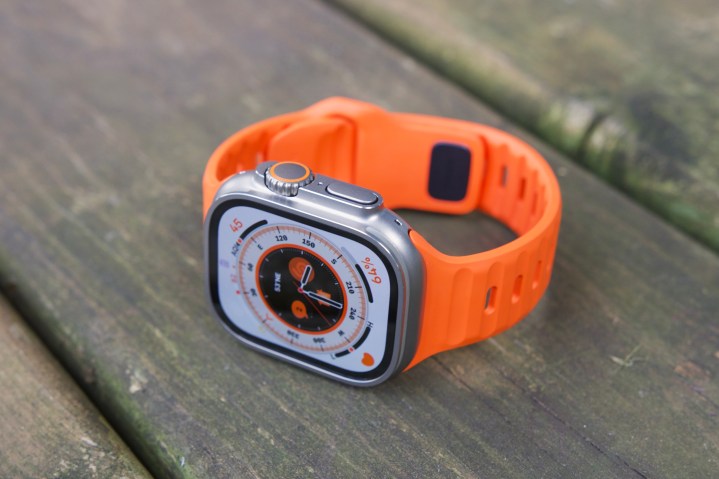
Nevertheless, when it comes to raw design specs, the Apple Watch Ultra 2 does have one significant edge over the Samsung Galaxy Watch Ultra. While both wearables are rated for 10 atmospheres (10ATM) of water pressure, which equals a depth of 100 meters, only the Apple Watch Ultra is certified for diving, with an EN13319 rating for use as a dive computer and for recreational scuba diving at depths of up to 40 meters.
That’s significant because despite being able to handle up to 100 meters of water pressure, Samsung says in the fine print that the Galaxy Watch Ultra is only suitable for “shallow-water activities like swimming in a pool or ocean.” That’s consistent with its 10ATM rating, which is designed only for swimming, snorkeling, or high-speed water sports like surfing and water skiing. That 10ATM designation means 100 meters of still water, and all bets are off when you exert extra pressure on it.
While it’s less relevant in light of the 10ATM rating, the Galaxy Watch Ultra also features an IP68 rating that matches Samsung’s higher-end smartphones. It’s fully dust-resistant and can withstand immersion in up to 1.5 meters of water for up to 30 minutes. Instead of an IP water-resistance rating, Apple hangs its hat on its 10ATM and EN13319 ratings, giving the Apple Watch Ultra only an IP6X for the same level of protection against dust and other small particles. However, unlike IP68/IPX8, the 10ATM rating covers salt water, so ocean swimming won’t be a problem. Both wearables are also tested to MIL-STD-810H for altitude, extreme temperatures, humidity, immersion, freezing and thawing, salt and fog, and shock and vibration.

The band attachment system is also worth mentioning here, as Samsung has done something slightly unusual with the Galaxy Watch Ultra. Rather than slanting downward toward the wrist, the bands connect at an angle parallel to the case, which makes the Watch sit a bit more awkwardly on the wrist. More significantly, the bands attach with a new dynamic lug system that’s unique to the Galaxy Watch Ultra. This will limit you to bands made specifically for the Galaxy Watch Ultra, leaving it out of the vibrant ecosystem of bands for every other Galaxy Watch model.
By comparison, the Apple Watch Ultra is compatible with every 42/44/45mm Apple Watch band released since the original 2015 Apple Watch. Some smaller bands may look a bit strange against the bulkier Apple Watch Ultra, but they’ll attach just fine.
Samsung Galaxy Watch Ultra vs. Apple Watch Ultra 2: display

Samsung’s and Apple’s Ultra wearables are more evenly matched in display quality. The Apple Watch Ultra features a slightly larger screen, with a diagonal length of 1.94 inches, compared to the Galaxy Watch Ultra’s 1.5-inch screen, but the latter makes up for that with a higher resolution, putting both roughly on par in terms of pixel density — 335 pixels per inch (ppi) for the Apple Watch Ultra 2 versus 320 ppi for the Galaxy Watch Ultra.

That’s not a difference anyone will notice with the naked eye. Tthe Apple Watch has a rectangular 410 x 502 display with 205,820 pixels, while the Galaxy Watch Ultra’s round 480 x 480 display only has 180,956 pixels as it has no corners to fill.
Both displays are plenty bright, reaching up to 3,000 nits of peak outdoor brightness. That should get you through even the sunniest outdoor adventures without any difficulty. Samsung has also embraced Apple’s red Night Mode, which is easier on the eyes in the dark and won’t affect your night vision on a camping trip or evening hike.
Samsung Galaxy Watch Ultra vs. Apple Watch Ultra 2: performance

Samsung has given its wearables a nice performance boost this year by adopting a new five-core Exynos W1000 chip that promises to be about 3x faster and 30% more power-efficient than last year’s Exynos W930.
It’s the first leap we’ve seen among Samsung’s watches in a while and should translate to a much smoother and more responsive user experience that will likely be more on par with the Apple Watch Ultra.
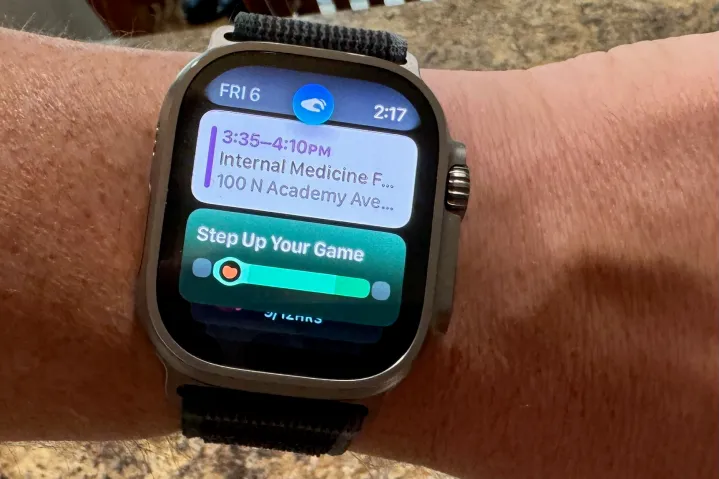
Apple’s watches have always run with buttery smoothness — we’ve often referred to them as the “gold standard for smartwatch performance” — with no lag at all. While last year’s Galaxy Watch 6 was fine on its own, the difference in performance was apparent when you compared them side by side. While the current Apple Watch Ultra is powered by Apple’s latest S9 chip that remains ahead of the pack, we expect the Exynos W1000 to close that gap significantly.
Samsung Galaxy Watch Ultra vs. Apple Watch Ultra 2: software and features

Samsung’s decision to stick with a circular display was probably a wise choice, considering that the Ultra runs the same Wear OS and One UI Watch software as the rest of the Galaxy Watch family. Trying to adapt that for a square screen would have been a can of worms that we’re sure Samsung didn’t want to open.
The Galaxy Watch Ultra is one of the first smartwatches to adopt Wear OS 5 and One UI 6 Watch. The latest Wear OS promises some nice efficiency improvements, as well as support for a new Watch Face Format that should provide more flexibility for third-party developers, translating to even more customization for Galaxy smartwatches.
The Apple Watch Ultra 2 ships with Apple’s watchOS 10, in which Apple introduced some of its own significant design changes last year. However, it remains familiar enough that anyone who’s ever used an Apple Watch should feel right at home. As with the iPhone, customizability is not Apple’s priority, so you’ll be limited to the built-in watch faces that Apple offers — although there are plenty to choose from.

Perhaps the most significant software change in the Galaxy Watch Ultra is the addition of Samsung’s Galaxy AI features. These use deeper AI-powered analysis of health and fitness data to summarize how your health is impacting your daily life — known as an Energy Score — and offer recommendations and coaching on how to improve things.
Despite Apple’s recent foray into Apple Intelligence, it’s not going there with the Apple Watch yet. Apple’s AI will be limited to the iPhone, iPad, and Mac, and there’s no word on when it’s coming to the company’s wearables.
For software updates, Samsung is now promising four major Wear OS and One UI updates. Apple doesn’t make specific promises here, but it typically supports its wearables with watchOS updates for at least as long.
Lastly, it’s worth remembering that the Galaxy Watch Ultra and Apple Watch Ultra both require a paired smartphone of a similar flavor. For Samsung’s watch, that can be nearly any Android 11 smartphone, although it works best with recent Galaxy S series or Galaxy Z series models. The Apple Watch Ultra 2 remains an Apple-only affair and requires an iPhone running iOS 17 or later.
Samsung Galaxy Watch Ultra vs. Apple Watch Ultra 2: battery life and charging

Efficiency improvements in Exynos W1000 and Wear OS 5 should help both of this year’s Galaxy Watch models achieve longer runtimes, but the Galaxy Watch Ultra takes that to new heights with a larger 590mAh battery and two power-saving models that could see it last for up to 100 hours between charges.
That’s if you go all the way into the standard power-saving mode, which shuts down the always-on display, wake-up gestures, background processes, and network and GPS services. You can also get up to 80 hours by turning off the always-on display or 60 hours during regular operation with always-on enabled. We’ll have to put it through its paces to see how the real-world performance aligns with Samsung’s promises, but we were pretty impressed with last year’s Galaxy Watch 6, so we have high hopes that the Galaxy Watch Ultra will deliver here.
The Apple Watch Ultra 2 has a similar low-power mode that can provide up to 72 hours of battery life in a pinch, assuming you have your paired iPhone nearby to handle the cellular connection. That 72 hours of runtime assumes 60 hours of that is connecting to the internet via Bluetooth to your iPhone, plus 360 time checks, 360 notifications, 180 minutes of app use, and two 60-minute workouts with music playback.
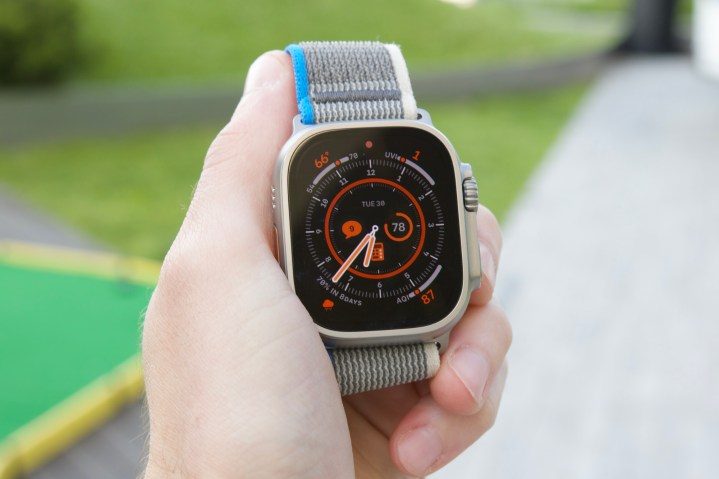
Apple’s low-power mode disables the always-on display and background health measurements for heart rate and blood oxygen, which also means you won’t get notifications for irregular heart rhythms or high/low heart rates. In normal mode, you can expect 36 hours of battery life, based on 80 time checks, 180 notifications, 90 minutes of app use, and a single 60-minute workout with music. This also assumes you only use the LTE connection for eight of those 36 hours.
Both wearables support wireless fast charging via the adapters that come in the box. The Apple Watch Ultra 2 can go from dead to an 80% charge in about an hour; Samsung doesn’t say anything about the charging times for the Galaxy Watch Ultra, but we expect it to be similar.
Samsung Galaxy Watch Ultra vs. Apple Watch Ultra 2: fitness and health tracking
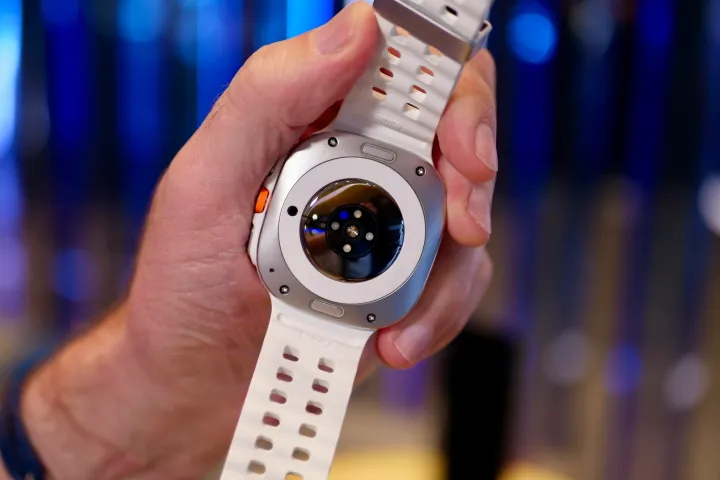
Samsung’s smartwatches have always been at the leading edge regarding health features, and the Galaxy Watch Ultra is no exception. This year, the Galaxy Watch lineup has distinguished itself by offering the first sleep apnea monitoring technology to be De Novo approved by the Food and Drug Administration (FDA), beating Apple to the punch on a feature that so far has only been rumored to be coming to the next-generation Apple Watch Ultra.
Sleep apnea monitoring is an extension of Samsung’s sleep tracking features, which have been a staple of the Galaxy Watch lineup for the past few years. However, this year, Samsung has added a more advanced AI algorithm for sleep analysis that should provide more accurate results. This feeds into the Sleep Apnea feature, which can proactively detect potential signs of moderate to severe sleep apnea. As with the health features in any consumer wearable, this isn’t a substitute for a diagnosis by a medical professional, but it can indicate that you should get yourself checked out.

Naturally, Samsung also continues to enhance its BioActive Sensor year over year, which means the Galaxy Watch Ultra can glean even more accurate readings for things like heart rate, muscle and fat mass, body water, body fat, and basal metabolic rate (BMR). There isn’t anything new here compared to prior Galaxy Watch models, but the numbers you get should be more precise.
On the fitness side, the Galaxy Watch Ultra offers a new Race mode that lets you compete against yourself by comparing your current performance against previous outdoor running and cycling workouts along the same route. The Functional Threshold Power (FTP) feature provides AI-powered metrics to help cyclists measure their maximum cycling power.
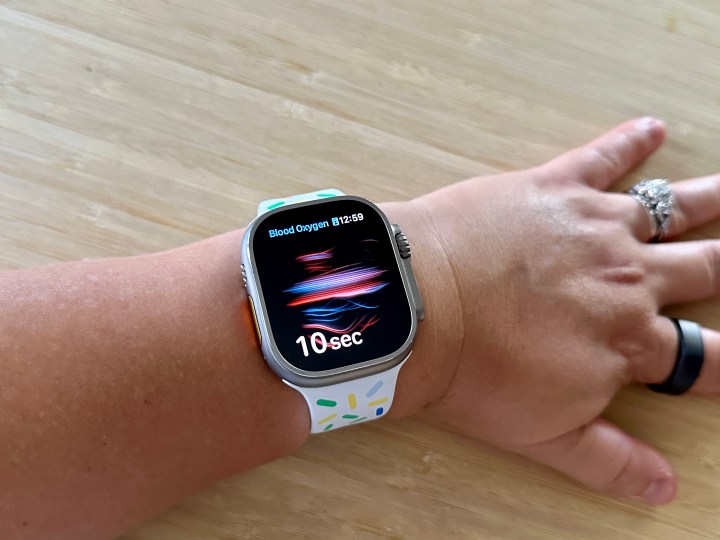
While the Apple Watch Ultra 2 packs in similarly advanced health features, Apple has slowed down a bit over the past couple of years. The last hardware health feature to come to its wearable was a body temperature sensor in the 2022 Apple Watch Series 8 and the original Apple Watch Ultra. Their 2023 successors didn’t add new hardware, although watchOS 10 brought cycling performance metrics and new hiking features to the wearable, including topographic maps and a Race Route feature akin to Samsung’s.
Apple’s Health features don’t provide the same comprehensive bioelectrical impedance analysis (BIA) profile of your body, so you’ll have to rely on other hardware. However, there’s a built-in ECG with comprehensive heart health tracking, including high, low, and irregular heart rhythm notifications, plus sleep tracking that includes respiratory rate and blood oxygen measurements (although the blood oxygen sensor is currently inactive on new U.S. models due to an ongoing patent dispute).
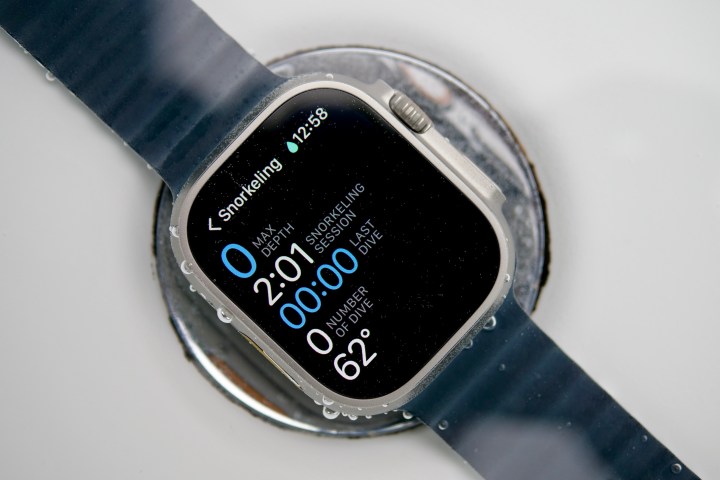
One area where the Apple Watch Ultra remains more “ultra” than Samsung’s nascent competitor is in outdoor hiking and diving activities. As we mentioned earlier, the Galaxy Watch Ultra is not suitable for deepwater swimming at all, while the Apple Watch Ultra is not only EN13319-certified for recreational scuba diving, but also includes a built-in depth gauge and water temperature sensor. A built-in Depth app provides basic readings and is accurate to plus or minus one meter. For those more serious about diving, Apple has partnered with Huish Outdoors to create the Oceanic+ app, which turns the Apple Watch Ultra into a fully functional dive computer.
The Apple Watch Ultra 2 also has some more established features for hikers, including detailed topographic maps for over 1,000 national and regional parks in the U.S. that show nearly every trail and point of interest, along with information like length and photos of trails so you can plan your hiking expedition. A Backtrack feature lets you easily find your way back to your point of origin or get back onto your route if you’ve strayed too far from the beaten path, and also shows you the last spots where you had full cellular service or emergency SOS calling so you can get back to coverage when you’re out in the wild.
Samsung added a similar Track Back feature to the Galaxy Watch Pro 5, and while it’s been exclusive to that model, it’s not surprising to see it’s made a comeback in the Galaxy Watch Ultra. However, it felt a bit niche and poorly fleshed out on the earlier model, so we’re reserving judgment until we’ve had time to see what Samsung has done with it.
Samsung Galaxy Watch Ultra vs. Apple Watch Ultra 2: price and availability

The Galaxy Watch Ultra is available in a single model that sells for $650, although you can get it in your choice of Titanium Silver, Titanium Gray, or Titanium White, with Marine, Trail, or Peakform bands. It went up for preorder on July 10, but you won’t be able to get your hands on one until July 24. That’s when the first preorders should arrive and when it will go on sale at major retailers like Amazon and Best Buy. Samsung is also running a promotion to give you an extra Trail Band if you purchase directly from its website.
The Apple Watch Ultra 2 costs $799 and can be purchased directly from Apple or at most other electronics retailers. The only color option is natural titanium, but you can choose from Alpine Loop, Trail Loop, or Ocean watch bands, each of which is available in three colors.
Samsung Galaxy Watch Ultra vs. Apple Watch Ultra 2: verdict

At the end of the day, your choice between these two excellent smartwatches will be dictated by the ecosystem you live in since you can’t use a Galaxy Watch with an iPhone or use an Apple Watch with an Android device. However, if you’re an outdoor adventure enthusiast who’s on the fence about switching to the other side, Apple’s and Samsung’s Ultra wearables may be enough to tip the scales. If we were to compare the two in a few words, Samsung’s wearable comes out ahead in health monitoring, while Apple’s excels at outdoor fitness exploits.
The Galaxy Watch Ultra is Samsung’s first legitimate attempt at a rugged adventure smartwatch, and it’s an impressive one. Samsung hasn’t so much copied the Apple Watch Ultra as it’s learned from it. The design similarities are superficial at best, and the Galaxy Watch Ultra still has its own unique style that sets it apart not only from Apple’s wearables, but also from the rest of Samsung’s Galaxy Watch family. It’s something entirely new and unique in the world of Wear OS smartwatches, and we don’t think Samsung fans will be disappointed with what it offers.
Nevertheless, the Apple Watch Ultra 2 still stands out as the true extreme smartwatch. The aesthetic alone signals its purposeful design, which is all about utility and durability and not fashion. That’s backed up by its ability to handle deepwater diving and be taken out onto wilderness trails with a greater degree of confidence. We’re also on the second generation of Apple Watch Ultra and will likely see the third appear in the next few weeks, so it’s a more mature product that’s had time to evolve and find a solid footing.
Services Marketplace – Listings, Bookings & Reviews